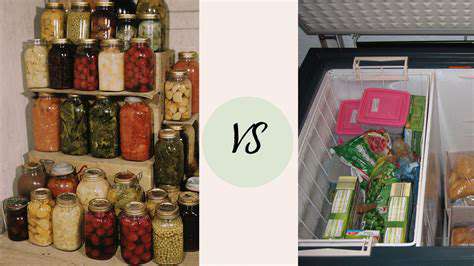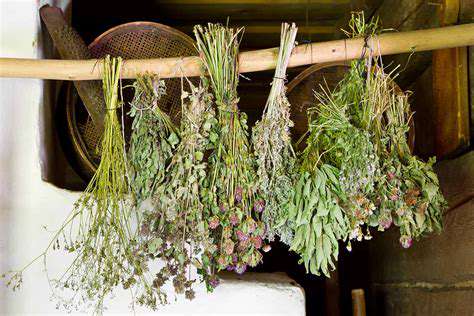Storing Fresh Herbs: Best Practices for Longevity
Jun 16, 2025 / btwgardenmachine/
Pre-Storage Preparation: Washing and Drying
Properly cleaning herbs before storage makes all the difference. Start by rinsing them under cool running water to eliminate dirt, debris, or pesticide residues. Handle delicate leaves gently to avoid bruising. After washing, use clean paper towels to pat them dry thoroughly. Removing excess moisture is critical—it prevents mold growth and significantly extends shelf life. Effective drying forms the foundation for successful preservation.
For leafy varieties like basil or parsley, a gentle shake removes water droplets. With stemmed herbs such as rosemary or thyme, separate leaves from stems before drying. The objective is to eliminate damp areas where harmful microorganisms thrive.
Choosing the Right Storage Method
Different herbs demand tailored storage approaches to preserve their freshness. Leafy herbs like basil prefer refrigeration, while woody herbs like rosemary store best in cool, dry spaces. Recognizing these differences is paramount for maximizing preservation success.
While some herbs tolerate various methods, understanding their ideal conditions ensures optimal results. Don't hesitate to experiment while keeping fundamental principles in mind.
Freezing Herbs for Extended Storage
Freezing offers an excellent solution for long-term herb preservation. Blanching—briefly immersing herbs in boiling water then ice water—helps maintain color and texture. This process deactivates enzymes that cause flavor degradation, preserving quality during frozen storage.
After blanching and drying, pack herbs in labeled freezer bags or containers. Proper labeling ensures easy identification later. When done correctly, freezing can preserve herbs for months without significant quality loss.
Drying Herbs for Long-Term Preservation
Air drying represents one of the simplest preservation methods. Hang cleaned herbs upside down in a dark, ventilated space. Complete drying before transferring to airtight containers. This technique works exceptionally well for robust herbs like rosemary, thyme, and oregano.
The absence of heat in this method helps retain natural flavors and aromas. Well-dried herbs can enhance dishes throughout the year without refrigeration.
Storing Herbs in the Refrigerator
Delicate herbs like parsley and cilantro benefit from refrigerator storage. Place them in glass containers with loose lids or wrap in slightly damp paper towels inside plastic bags. Proper air circulation prevents moisture buildup while maintaining freshness.
This method slows natural deterioration, allowing you to enjoy fresh-tasting herbs for up to two weeks. The key lies in balancing moisture control with adequate ventilation.
Using Herbs Immediately After Harvesting
For peak flavor and aroma, use herbs soon after harvesting. Freshly picked basil and cilantro offer unparalleled vibrancy that diminishes over time. Immediate use eliminates storage concerns while delivering maximum culinary impact.
This approach also reduces food waste and storage effort. When possible, harvest only what you need for immediate preparation.
The Power of Refrigeration: A Versatile Storage Method

The Fundamentals of Refrigeration
Modern refrigeration systems operate through sophisticated heat transfer mechanisms. By cycling refrigerants through compression and expansion phases, they effectively remove heat from enclosed spaces. This technology revolutionizes food preservation while impacting numerous industries.
Efficient system design minimizes energy use while maximizing cooling capacity. Understanding these principles helps optimize performance and reduce environmental impact.
Applications Across Industries
Refrigeration's influence extends far beyond kitchen appliances. In food production, it prevents spoilage and foodborne illnesses. Pharmaceuticals rely on precise temperature control to maintain vaccine efficacy and medication stability.
Industrial processes utilize refrigeration for quality control, while laboratories depend on it for sensitive experiments. Climate control systems adapt refrigeration technology for human comfort in buildings worldwide.
Environmental Impact and Sustainability
The refrigeration industry faces significant environmental challenges. Traditional refrigerants contribute to global warming, driving innovation toward eco-friendly alternatives. Energy-efficient designs and sustainable refrigerants represent crucial solutions for reducing climate impact.
Ongoing improvements in insulation and compressor technology continue to enhance efficiency. These advancements help reconcile refrigeration benefits with environmental responsibility.
The Future of Refrigeration Technology
Emerging technologies promise smarter, greener refrigeration solutions. Advanced refrigerants, AI-driven optimization, and predictive maintenance systems are transforming the industry. These innovations will deliver greater efficiency while maintaining reliability standards.
Integration with smart home systems and IoT devices will further enhance user control and energy management. The future points toward increasingly sustainable and intelligent refrigeration solutions.
Freezing for Extended Storage: A Long-Term Solution

Freezing for Extended Storage: Introduction
Freezing effectively pauses food degradation by halting microbial growth and enzymatic activity. This preservation method maintains nutritional value while extending usability. Proper technique ensures optimal results throughout the storage period.
Choosing the Right Containers
Container selection directly impacts freezing success. Airtight, freezer-safe materials prevent moisture loss and freezer burn. Proper packaging preserves texture and flavor during extended storage. Size-appropriate containers facilitate even freezing and convenient portioning.
Preparing Food for Freezing
Preparation steps vary by food type but share common principles. Thorough cleaning and moisture removal prevent ice crystal formation. Proper portioning enables convenient usage while minimizing waste. These measures collectively ensure high-quality frozen products.
Freezing Techniques for Different Foods
Blanching vegetables before freezing preserves color and nutrients by deactivating enzymes. Meats benefit from vacuum sealing to prevent oxidation. Understanding these specialized techniques maximizes preservation quality across diverse food categories.
Thawing Frozen Food Safely
Refrigerator thawing represents the safest method, preventing bacterial proliferation. Proper thawing practices maintain food safety while preserving quality. Avoid room temperature thawing to minimize health risks.
Freezing Considerations and Storage Guidelines
Maintaining consistent freezer temperatures ensures food safety. Adhering to recommended storage times preserves optimal quality. Organized storage with clear labeling simplifies inventory management and reduces waste.
Drying Herbs: A Natural Preservation Technique

Drying Herbs: A Simple and Effective Method
Herb drying transforms seasonal abundance into year-round pantry staples. This cost-effective method requires minimal equipment while delivering maximum flavor. When executed properly, dried herbs can rival fresh ones in culinary applications.
Robust herbs like rosemary and thyme dry particularly well. The process preserves their essential oils, maintaining potent flavors for future use. Proper storage in airtight containers extends usability for months.
Optimizing Your Drying Environment
Successful drying depends on environmental control. Well-ventilated spaces with moderate temperatures produce the best results. Consistent airflow prevents mold while preserving herb quality. Avoid humid areas that can lead to spoilage during the drying process.
Temperature moderation is crucial—excessive heat degrades flavor compounds. A stable, warm environment ensures uniform drying without compromising quality.
Proper Drying Techniques for Optimal Flavor Retention
Morning harvesting captures peak essential oil content. After gentle cleaning, arrange herbs in single layers for thorough air exposure. Dehydrators offer precision control for consistent, efficient drying compared to traditional methods.
Complete drying before storage prevents mold growth. When properly executed, this technique preserves herbs' vibrant characteristics for extended culinary use.